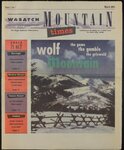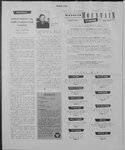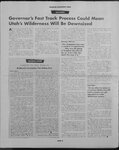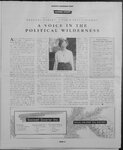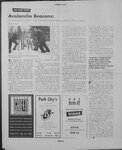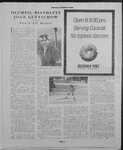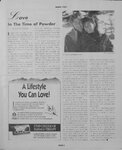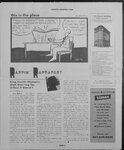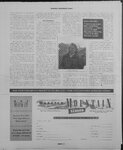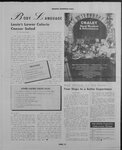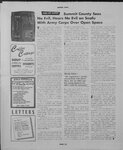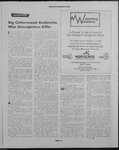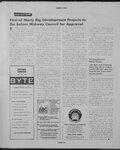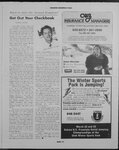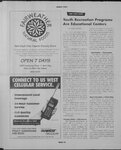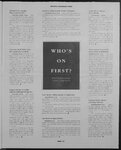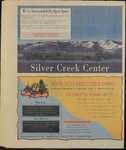| OCR Text |
Show WASATCH CANYON MOUNTAIN TIMES REPORT yoming Big Cottonwood Avalanche Was Unsuspicious Killer t was just another fun weekend of backcountry skiing in the Wasatch Mountains, until an unlikely slab avalanche roared down on three Salt Lakers, throwing them forcefully into a grove of trees and burying them. One died. The second was seriously injured and could have died. The third member was buried up to his neck but walked away after passersby dug the trio out. Their route, from Mill A Fork to Gobbler’s Knob on Big Cottonwood Canyon’s north side, was a common one and not overly hazardous. Yet, in just seconds their weekend turned tragic. When Steve Carruthers, Marshall Denton and James Paul set out Sunday, February 12, they were relatively well-prepared for a backcountry tour. All three were experienced backcountry skiers, prepared for the winter mountains. The trio had probably been hiking upward for about one hour, following a trail cut by another group. The route in Mill A Fork, traversed the west Butler drainage, en route to the Gobler’s Knob-Mt. Raymond Saddle, located generally above the “S” curve in Big Cottonwood. Shortly after noon, the trio began to break its own trail through the dense snow. The party of five that had been breaking trail ahead of the trio, had stopped to ski the “Butler Trees,” unsure whether the route up to Gobbler’s Knob was a safe bet. One of the first group — the fivesome — recalled stopping before proceeding up toward Goblers Knob. Larry Dunn, said it was snowing hard and visibility was poor. “It wasn’t a good day for Gobbler’s.” A one point, the trio who would be caught in the slide, passed in close enough proximity to Dunn’s group to exchange greetings. “This group passed us. They said they were going to Gobbler’s,” Dunn recalled in a Wasatch Mountain Times interview. Following the avalanche and the subsequent rescue, there was speculation that perhaps the Carruthers trio had not been cautious enough. But avalanche forecaster Seth Shaw, and backcountry avalanche specialist Bob Athey, both said their route was not one known for hazards. “It was an unsuspicious spot (for an avalanche),” said Shaw in a telephone interview from the Avalanche Forecast Center. “But when you’ve got a lot of new snow, the avalanche danger jumps up.” Dunn’s fivesome skied the Butler Trees and then hiked back up to the trail, where they had come across the Carruthers trio. The weather began to let up. Dunn’s group began discussing the option of going up to Gobbler’s Knob, after all A member of Dunn’s_ group, Graham Stork, said he and his friends were wary of the route up to Gobbler’s Knob because a snowfall of about 30 inches in combination with the steep slopes in the area could spell trouble. “We had decided earlier that day, that if we went up to Gobbler’s Knob, the safest route was the low trail,” Stork said. “But they (the Carruthers trio) had made the decision not to take the low road.” With more than two feet of new snow, the decision to break a second trail — and take the low route instead of following the trio — would mean a lot of extra work. But before Dunn and Stork’s party had reached the point where that decision had to be made, Stork thought he heard cries. A little further along the trail, it became clear that something awful had happened. “Based on the level of panic in those calls for help, I was sure something was seriously wrong,” Stork remembered. Dunn and physician Al Trerse, another member of the fivesome, were first to arrive at the slide area. They quickly directed Stork to go for help. “Larry yelled to me to go as fast as I could go,” Stork recalls. “It was clear that it was a very serious situation.” What Dunn and his party found was that Marshall Denton and James Paul had been swept several hundred feet by a dense, slab avalanche down the slope into a grove of trees. Denton and Paul were buried up to their necks, although Paul had one hand free. There was no sign of Carruthers. “The first question we asked, was how long ago did this happen?” Dunn said. “I confirmed there had been three of them . . . Marshall told me that they had been buried for 20-to-30 minutes, at least.” Snow and weather conditions were prime for an avalanche that day, explained long-time backcountry skier Alexis Kelner, who with David Hanscom, authored “Wasatch Tours,” a guide for backcountry skiers. Kelner said an avalanche was not hard to predict, because it had not snowed for a long time, making the surface very icy, before the large snow storm that clobbered the Wasatch that day. But what really made _ the avalanche danger high was the fact that it began snowing before the tem- oolens Is Proud To Be A Part Of The Wasatch Mountain Times We hope interest in making The of Your You will take a vested Your surroundings by Times an important part Mountain Lifestyle Wyomine Wear - rere Fee sl JACKSON HOLE, USA Adventure Designs For The Wasatch Back Country Wyoming Woolens 518 Main Street Park City, Utah 801-645-9427 perature dropped, explained forecaster Seth Shaw. A light layer of snow blanked the mountains before the temperature increased. A dense layer of one-to-two feet was then dropped by the storm. “The avalanche ran on the lightdensity layer,” Shaw said. ether or not the trio triggered the slide is a question of debate. Dunn recalls noticing that the avalanche broke out above the trail cut by the trio. But Shaw, after inspecting the site a day later, said the avalanche was most likely caused by the skiers crossing the slope. But what caused the slide was irrelevant when Dunn’s group arrived on the scene. “We had to make some decisions,” Dunn recalled. “Marshall was in a great deal of pain. He was wrapped around a tree, shivering and possibly going into shock . . . We made a conscious decision at that point to at least save Marshall before looking for the other person.” Dunn explained that the rescuers held little hope for Carruthers because he had already been buried for about 30 minutes. Freeing Denton, who suffered serious leg injuries, took about 10 minutes. The remaining rescuers then conducted a beacon search, using radio locators, and found Carruthers in about another five minutes. “Our shovels struck him about 1to-2 feet below the surface,” Dunn said. “There was no pulse .. . We began CPR (cardio-pulmonary resuscitation) right then .. . There were signs of severe trauma to the head and neck.” It was unclear whether Carruthers died of suffocation or injuries he suffered while being swept into the trees. But members of Dunn’s group kept up the CPR until the rescue helicopter arrived — some four hours later. Steve Carruthers was 37 years old and is survived by a wife and two children. The avalanche reinforces the dangers of backcountry skiing. In particular, skiing near slopes of 35 degrees or more (expert terrain) following snowstorms can be dangerous. Other factors that add to the danger are temperature changes and strong winds that tend to pile up snow on leeward slopes. The choice that Carruthers, Denton and Paul made to cross the mountain where they did was not necessarily a reckless one, said Bob Athey. “I have taken that route many more times than I have avoided it.” The tragedy serves to reinforce the notion that anyone in the winter backcountry, whether they are snowmobilers, snowshoers, snowboarders skiers, can’t be too cautious. “It is a dangerous activity,” Dunn, in reflection. “You have or says to accept the risks involved and deal with them by using avalanche safety, by being conservative and by not taking any unnecessary chances . . . Safety must be at the forefront every time you are out.” @ |

